WSD and shrimp
White spot disease (WSD)
- Can affect most of the aquatic crustaceans
- Can cause up to 100% mortality
- Can have a serious economic impact on cultured shrimp
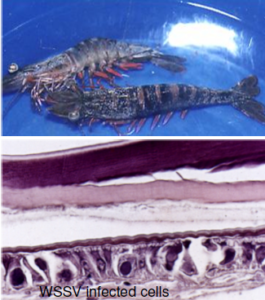
Causative agent of WSD
Taxonomy
- Family: Nimaviridae
- Genus: Whispovirus
- Type species: White spot syndrome virus
WSSV genome
- A double-stranded circular DNA genome of over 300 kbp
- Over 90% of the WSSV ORFs show no significant similarity to other known proteins
Uniqueness
- Very broad host range
- Replicates very rapidly in shrimp
- Lots of anti-host defense strategies
- A disease that is very difficult control
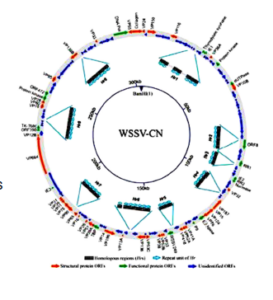
A losing battle for shrimp infected with WSSV
The host ROS can be neutralized at initial stage of infection
How does the virus do that ?
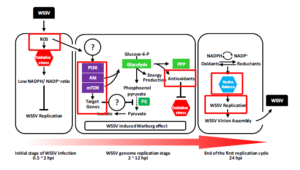
White Spot Syndrome Virus Protein (PK1) Defeats the Host Cell’s Iron Withholding Defense Mechanism by Interacting with Host Ferritin
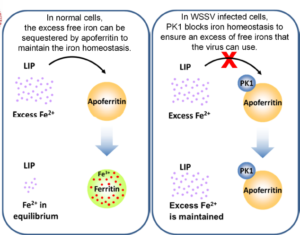
The defense proteins (e.g. NFkB and STAT) can even be co-opted by the WSSV IE1 gene
The outcome of stocking a pond with WSSV carriers
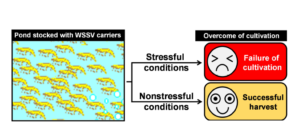
WSSV annexes shrimp STAT to transactivate ie1 expression
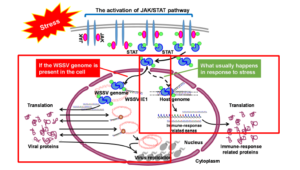
A novel DNA mimic protein expressed at the late phase of infection leads to the death of the shrimp
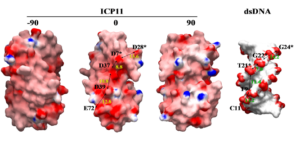
How does ICP11 work
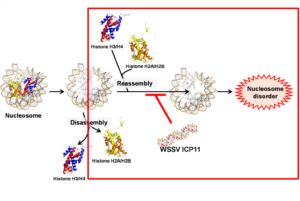
The shrimp can be overwhelmed by ICP11
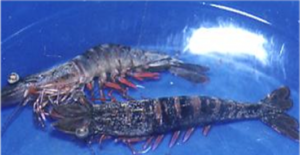
When ICP11 is being expressed, the infection will very quickly lead to the death of the shrimp
Controlling WSD
- Monitor and survey for the presence of the virus, and then quarantine, or otherwise keep separate, the virus and its shrimp host
- To some extent, this is indeed helpful
From WSSV Emergence to Global Pandemic
Emergence of WSD in 1991-1994
- Emergence of WSD in ~1991-1994 from East Asia
- Since then, despite our best efforts, it’s spread to become an almost global pandemic
Looking beyond Diagnosis and Quarantine
- During 2010 to 2012, WSSV caused severe mortalities in cultured penaeid shrimp in Saudi Arabia, Mozambique and Madagascar
- It was suggested that the WSSV epidemics in these 3 countries were from a common source, and that this source was possibly the environment
Looking beyond Diagnosis and Quarantine
- This suggests that we need to look beyond diagnosis and quarantine
- This is an enormous challenge
What can we do to help the host more successfully defend itself against WSSV?
Interventions that help shrimp in the arms race against WSSV
Production of WSD resistant shrimp
Center For Shrimp Disease Control And Genetic Improvement

- A shrimp genome biology laboratory
- A shrimp disease laboratory
- An OIE reference laboratory for white spot disease
- Two Nuclear Breeding Center buildings
- Both of which have their own hatchery and nursery facilities as well as their own facilities for maturation and multiplication of shrimp families of interest
- All with high biosecurity
- All shrimp in these buildings are at least SPF
Research and development for WSD resistant shrimp production
WSSV-resistant shrimp
We are primarily interested here is resistant shrimp – that is, shrimp in which the virus is unable to replicate.
Research and development for WSD resistant shrimp production
WSSV-resistant shrimp
We are primarily interested here is resistant shrimp – that is, shrimp in which the virus is unable to replicate.
Looking for the host factors which are necessary for infection and virus replication
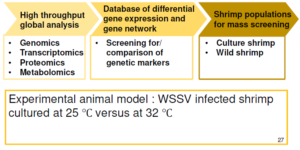
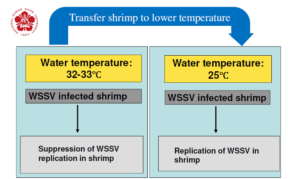
- The virus is not being killed at 32℃, but its replication is being suppressed .
- This implies that there are some factors that are critically different between these two temperatures.
Identifying the host genes that are critical for virus replication
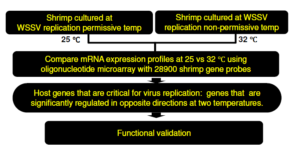
Temporal expression profiles of individual genes that suppress the virus replication
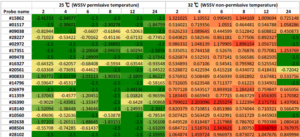
- These are genes that are down-regulated at WSSV-permissive temperatures
and up-regulated at non-permissive temperatures. - All of the genes shown here are the possible virus suppressing genes, i.e. genes
that might suppress virus replication
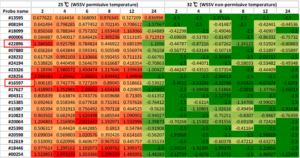
- These are genes that possibly promote the virus replication.
- To confirm this, we picked two of these (# 22896 and # 16579) at random to look at what happens when they’re silenced.
What happens when the viruspromoting genes are silenced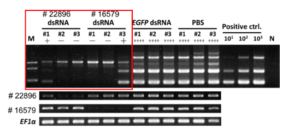
If either of these two virus- promoting genes was silenced, the virus no longer replicates. A single gene is sufficient to control virus replication.
Using the candidate genes to find a shrimp population with high genetic diversity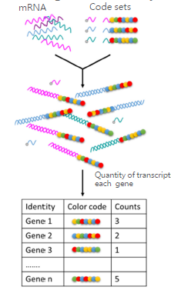
- NanoString nCounter gene expression analysis system
- 152 genes related to virus replication
- Our first objective was to identify shrimp populations with high genetic diversity

Gene expression profiles produced by the nanostring nCounter analysis
- The gene expression profiles of those 152 genes for six different populations.
- Each population is represented by 4 to 8 individual shrimp.
- Clustering analysis put shrimp from the same populations in the same cluster.
- Within a population – we’re looking for the greatest diversity expression patterns.
– This will give us the populations with the most genetic diversity .
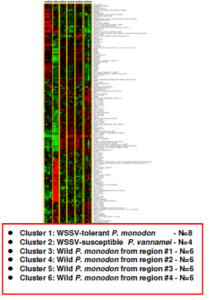
Screening natural populations for WSSV resistant shrimp

- By screening natural populations of the Penaeus monodon with the most genetic diversity, we have successfully identified and bred WSSVresistant shrimp
Detection of virus genomic DNA in the WSD resistant shrimp challenged with WSSV
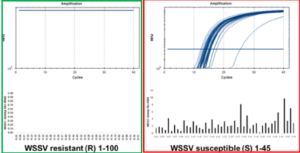
- When these shrimp were challenged with the virus, the WSSV-resistant shrimp all survived , and no virus genomic DNA were found in these WSSV-resistant shrimp.
- By contrast, all of the susceptible shrimp died, and these shrimp were found to have a large virus load.
- We were lucky enough to find four lines that are WSSV- resistant.
Expression levels of 10 virus promoting genes in shrimp individuals infected with WSSV
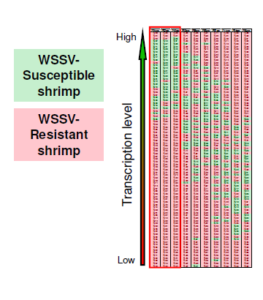
- Three of these genes are producing consistent results.
- These genes consistently have low expression levels in the WSSV-resistant shrimp
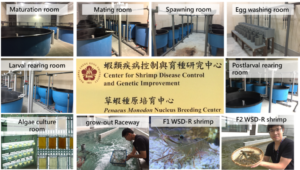
We have established an indoor culture facility with a high level of biosecurity and a closed circulation water system.
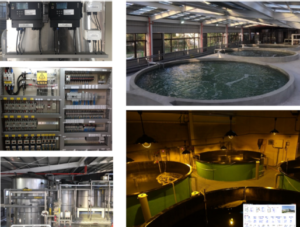
This system has smart control system for the water quality and light. Using this system, we can support the resistant shrimp through their complete life cycle, and thereby producing their F3 generations of resistant lines
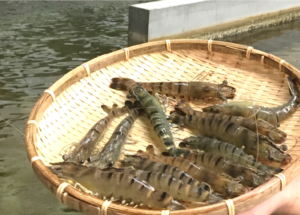
Could the WSD-resistant trait be passed on to the next generation?
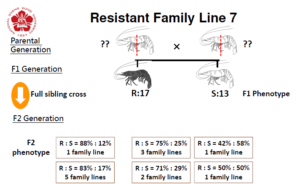
Genotyping of WSSV- resistant and susceptible populations using genotyping by sequencing.
Virus resistance test to identify individual resistant and virus susceptible shrimp
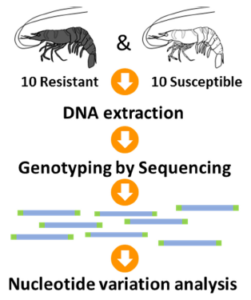
- We have identified 50 SNPs from the GBS (Genotyping by Sequencing) data and checked these SNPs by using PCR with other samples from different families.
- We found SNP #3 from our GBS data is one of the candidate markers that can distinguish resistant shrimp from susceptible shrimp.
Genomic breeding for shrimp with desired traits
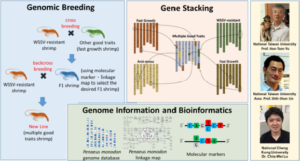
- We start by cross breeding resistant shrimp with fast growth shrimp.
- We can then use our resistant markers and linkage map to select those F1 offspring that have the desired genes, and back-cross these shrimps with other resistant shrimp to produce a new, stable with two copies of the resistance gene as well as the fast growth genes.
Genome editing
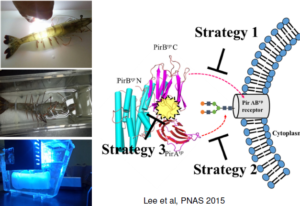
Shrimp/Pathogen/Environment interaction
Microbiota of the pond water, shrimp gut and substratum
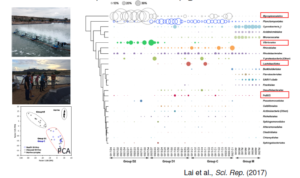
Conclusions
So we have seen that: These resistant shrimp do not allow replication of the virus.
And also that: The SNPs are vital for our marker –assisted breeding program because we can now identify resistant shrimp without having to challenge them.
In the future: we next plan to breed shrimp that have a combination of markers for desirable traits. These shrimp should thus exhibit a combination of desirable traits, including both resistance and fast growth
Source: Society of Aquaculture Farmers (SAP)
